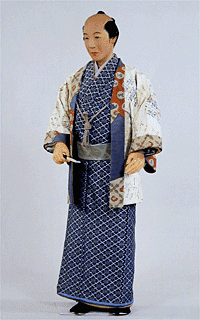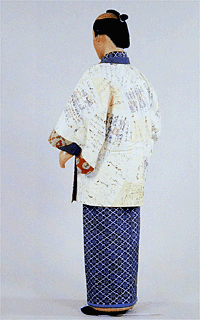THE HAORI, A GARMENT ORIGINALLY MADE FOR MEN
- TABITABIYA
- May 26, 2022
- 3 min read
Although it is, nowadays, indifferently worn by men and women alike, the haori, a jacket for kimono, has for long been exclusively worn by men only…
HAORI AND SAMURAI
It all seems to start in very ancient times, towards the end of the Muromachi Era Muromachi-Jidaï 室町時代 (1336 -1573), whose period called "Sengoku-Jidaï 戦国時代" (the Provinces at War) saw many warriors cross iron on its many battlefields. In these days of great trouble, to keep warm, the soldiers wore, over their armor, a sleeveless jacket called jinbaori 陣羽織. In the same way as the tabards worn on armor in medieval times, the jackets of high-ranking warriors were then adorned with bold colors and patterns. They were also the means of affirming, for the General in particular, the prestige and the strength of his clan in the face of his enemy.

Reconstruction of a warrior's outfit with his jinbaori for the historical festival of Gifu prefecture. Photo by Duck Nicholson (May 5, 2009)

Photo of Shogun Koboto Santaro wearing a jinbaori 陣羽織 over his armor (hand colored photo by Felice Beato, 1863)
Even after Japan was reunited and pacified during the Edo Era Edo-Jidai 江戸時代 (1603-1867), the haori, although considered as a casual garment in comparison to the kamishimo 裃 worn for formal occasions, remained an indispensable part of a samurai outfit.

photo of samurai Yoshida Youtokou 吉田 庸徳, who died of illness in 1880. He wears a black haori with his white coat of arms on the sleeves, montsukikurobaori 紋付黒羽織. Photo by photographer Shimooka Renjō 下岡 蓮杖, pioneer of Japanese photography.

Samurai wearing a kamishimo
At the same time, in addition to the samurai and people of high rank in their community, the rising class of wealthy merchants, very keen on fashion and eager to expose their status, adopted this Japanese garment for its practicality. Due to the ban issued by the Shogunate at the time and which we have already told you about in our article on Sarasa 更紗, Edo-komon 江戸小紋 patterns or shima stripes しま were in vogue. The rising influence of merchants in society meant that the haori ended up being worn by all men of the time who thus had the means to be fashionable without being wealthy or of high status.
City dweller wearing a haori over his kimono in the Edo period. Tokyo Costume Museum
It was not until modern times that the haori took on its current form. And still today, it is an essential element of formal attire, in kimono, for a man. But we will come back to this later.

Young students during the seijinshiki 成人式 ceremony, which marks their coming of age. Again, this young man wears a black haori with the montsukikurobaori family crest 紋付黒羽織 with his hakama Photo by Color Lounge.
Same here, this man wears a black haori with the montsukikurobaori family crest 紋付黒羽織 with his hakama for his wedding ceremony Photo by amira_a

The haori for men continues to be a source of inspiration. The Japanese clothing brand Trove, based in Tokyo, revisits the haori for men, in a more modern light. Very sober, very chic ...
What about women ? This is indeed the question as the image of the haori is nowadays a very feminine one. Well, the story of Japanese women with this traditional Japanese garment was a rather complex one… To be continued...
@TABITABIYA

BEWARE! No use, copy or other of our texts and images can be made without our prior agreement.
























Comments